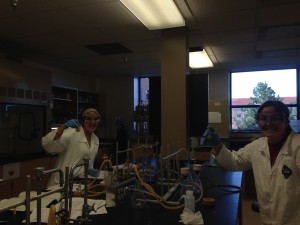As week three comes to a close, the Orgo I students finished up their last experiments and checked out of lab. The foundations of organic structures and configurations have already been established in the first two weeks of class leading up to the final full week where concepts are expanded to reagents and mechanisms of reactions. Learning the multitude of reagents and understanding mechanisms is challenging and overwhelming at times, but allowing these two concepts to become a way of thinking instead of memorization is one of the keys to success in organic chemistry (along with hard work and plenty of chemistry jokes of course). With the introduction of mechanisms and reagents, students are now able to propose and conduct different synthesis routes to produce a desired final compound, which is exactly what occurred in lab. The lab this week was spread out over two days, with each day dedicated to one of the two steps of the synthesis of diphenylacetylene, a compound containing two phenyl groups attached by an alkyne or carbon-carbon triple bond.
The first day, students performed an addition reaction to add two bromine atoms to a carbon-carbon double bond. To determine if the bromines were added syn (on the same side) or anti (on opposite sides), a melting point of the product stilbene dibromide was taken. The high melting point of the product indicated that the anti addition occurred to form a meso compound incapable of rotating plane polarized light. In addition to melting point, students worked through the mechanism of this reaction to provide an explanation for why the anti addition occurred.
A new theme in all organic chemistry classes at Colorado College is the use of green or environmentally benign reagents as alternatives to typical procedures requiring the use of extremely toxic or hazardous chemicals. To eliminate the use of corrosive liquid bromine as a reagent to brominate the starting material trans-stilbene, bromine was produced in situ (in the reaction mixture) by the use of pyridinium tribromide, which exists in equilibrium with pyridinium bromide and elemental bromine (Br2). As the elemental bromine is used up in the reaction, the equilibrium is pushed further to the right as explained by Le Châtelier’s principle to replace the reacted bromine, therefore providing a continuous “slow release” of bromine. Thus the reaction is able to proceed to produce the desired product and avoid the use of hazardous liquid bromine. Although it’s sometimes exciting to add a bit of danger to one’s life, this is definitely a case where the use of an alternative, safer procedure is greatly appreciated by both students and professors.
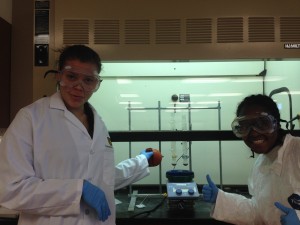
After students isolated stilbene dibromide using vacuum filtration, the samples were analyzed using Nuclear Magnetic Resonance (NMR). The NMR instrument, by far my favorite form of analysis in organic chemistry, detects signals of different atom isotopes depending on the specifications of the study being run. This time, everyone ran a proton NMR, which detects the spin signals (up or down) given off by neighboring protons. Where the signal for a proton appears on the spectrum depends on the electronegativity of the surrounding atoms.
The more electronegative or de-shielded the environment of a proton, the more downfield or to the left the signal will appear. In contrast, the more shielded a proton is, the more upfield or to the right of the spectrum a signal will appear. Analysis of a spectrum can provide a chemist with information regarding connectivity, structure, and composition of a particular compound. Pretty amazing if you ask me! Although the students seemed a bit more impressed with the pressurized sample loading system than the actual mode of action of the instrument, NMR data collecting went smoothly and it was onto the final step of the synthesis.
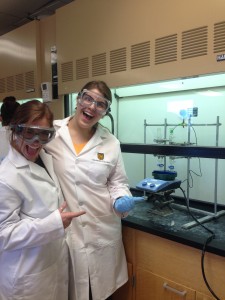
On day two of the synthesis, students worked on a double dehydrohalogenation of stilbene dribomide, or the formation of a carbon-carbon triple bond to produce the desired product diphenylacetylene. To isolate and purify the final product, students practiced a new technique: recrystallization. This technique is based on the principle of solubility, specifically that solubility increases with temperature. Using the minimal amount of a hot solvent to dissolve the crude product caused the impure crystals to deform and allow new, pure crystals to form as the solution cooled down and solid begun to crash out of solution. These pure crystals were separated from the liquid containing impurities by vacuum filtration and then analyzed by Infrared Spectroscopy (IR) and NMR.
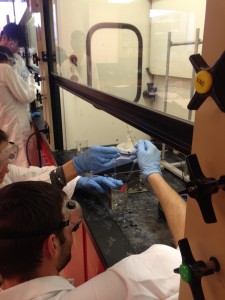
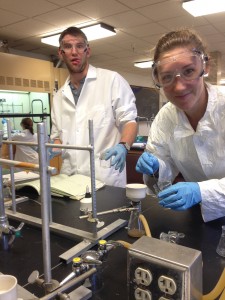
Although this blog was filled with quite a bit of organic chemistry jargon, I hope I made it accessible to everyone, even those students who took chemistry in high school and decided it was not their cup of tea. Hopefully the joy of accomplishing a synthesis or understanding a new concept was expressed through the pictures and my rambling about the procedure. If you can’t tell, I find the whole synthesis process quite fascinating. Stay tuned for Organic Chemistry jeopardy (yes it exists and is the only kind of jeopardy where I can actually answer any of the questions) and a wrap up of the final three days of class!
